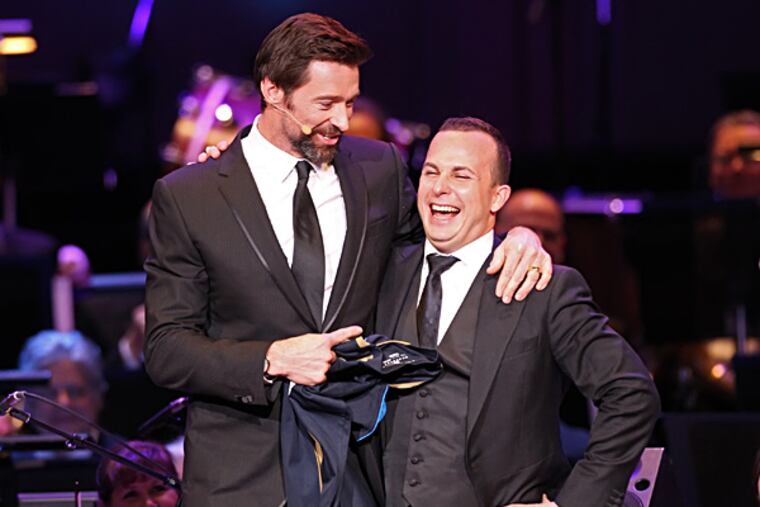At Academy ballroom, it's 1860 again
Workers from the Mathieu Lustrerie atelier in Gargas, France, visited Philadelphia last week to install 12 new chandeliers in the Academy of Music ballroom. Mural painters sat perched on scaffolding, putting the last blue hues and faux-marble touches on various parts of the building. Plaster repairs and roof work are complete, and after a new rug goes down in the next few weeks, the work is done. For this summer, at least.

Workers from the Mathieu Lustrerie atelier in Gargas, France, visited Philadelphia last week to install 12 new chandeliers in the Academy of Music ballroom. Mural painters sat perched on scaffolding, putting the last blue hues and faux-marble touches on various parts of the building. Plaster repairs and roof work are complete, and after a new rug goes down in the next few weeks, the work is done. For this summer, at least.
The Academy ballroom renovation, overseen by Philadelphia interior designer John Trosino of KlingStubbins, strips away a scheme installed in the 1950s, replacing it with cues taken from an 1860 photograph magnified to reveal minute details.
Planners say it's nothing less than an authentic reproduction of an entire room - not the familiar grand main auditorium, but the more modest space whose windows face Broad Street.
Those glass panes are clear now, but until a few months ago this was one of the city's most wonderfully situated rooms without a view, its windows having been soundproofed and covered by mirrors. Now the Broad Street windows and doors allow natural light into the 40-by-80-foot space for the first time in decades. Faintly colored stained-glass transom windows depicting musical instruments have been uncovered and restored. The chandeliers are detailed re-creations of what is guessed to have once existed there - some sculpted with monkeys playing cymbals and lyres.
The difference between the previous ballroom and the new one is startling. Academy leaders prohibited too much photo-taking last week, preferring to save the visual impact for donors, they said. But the space, much brighter with newly painted portraits of Bach, Haydn, Mozart, and Beethoven, as well as scenes from Mozart operas, is slated to open to the public Sept. 23, the same day as a tribute to Leonore Annenberg, the late philanthropist and queen mother to the Academy and the Philadelphia Orchestra. She and her husband, Walter, directed about $100 million to both institutions during several decades of involvement, says outgoing orchestra chairman and former Academy president Harold A. Sorgenti.
Mrs. Annenberg gave $5.6 million to the Academy ballroom project, with the rest of the $10 million cost coming from Academy endowment, anniversary ball proceeds, and other donors.
Ironically, the restoration funded by Mrs. Annenberg won't be enjoyed by another group with which she was involved. The space - which a Kimmel Center spokesman said will rent for $3,000 a day - has become too expensive for the Morning Musicales concerts, produced by the West Philadelphia Committee for the Philadelphia Orchestra, of which Annenberg was a member.
The Academy is managed by the Kimmel Center, even though the orchestra owns it and oversees major renovations such as the ballroom project. Morning Musicales, held for 46 years in the ballroom until displaced by the renovations, will move to the Curtis Institute of Music for at least the coming season, one of its leaders says.
Philadelphia Orchestra chamber music concerts moved from the ballroom to the Kimmel Center along with the orchestra in 2001. Some of the orchestra's Sound All Around concerts for young children will return to the ballroom this season.
A Kimmel spokesman did not provide details about what is expected to be booked in the ballroom in the coming season.
Other changes have taken place at the Academy during the summer. Past the foyer, in the north and south staircases, the jaundiced faux marble of the curved walls has a new color scheme. Rather than yellow - with red highlights made at some point, strangely, with permanent marker - the walls are now a brightened white-gray faux-marble pattern.
The Broad Street side of the building will change fairly dramatically in the next month. Philadelphians have long accepted the darkish brown coating over the masonry as authentic. But it will be lightened, from dark chocolate to a cappuccino color closer to the original.
Academy president Joanne McNeil Lewis points out that once the Broad Street facade looks better, the Locust Street side will appear more conspicuously in need of attention - another fund-raising opportunity, she says. "It's going to look very obvious."
A blanket of absolute quiet was the acoustical good achieved by shutting off the ballroom from the outside world in the 1950s. Now, with the windows clear again, a new rug and other changes, what will the room sound like?
We'll have to wait for the first concerts to learn anything about the interior sound. But passing sirens and bus roars should be kept to a minimum by a double set of doors, each with double-paned glass and rubber acoustical seals.
The rumble of the Broad Street subway that vibrates up through the building? The Kimmel Center was built with rubber seals insulating its two halls from trains. But in the Academy - now looking more circa 1857 than it has in decades - that sound is here to stay, an irrepressibly contemporary audio link to the world outside.